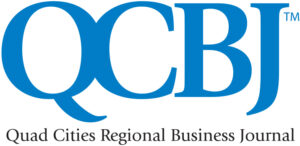Public art not only can be inviting, colorful and welcoming, but it can lend vitality to the economic development of a region, Quad Cities art advocates contend.
Community leaders say “wall art” attracts and keeps the younger generation in the region in addition to job offers they receive. This is one of key reasons businesses should care about the arts in their area, said Kevin Maynard, executive director of Quad City Arts.
Mr. Maynard, who leads the Rock Island-based not-for-profit, jumped on his soapbox as he spoke about both the present explosion of wall art and sculptures across the region’s downtowns — and the future plans for more.
“Millennials and Gen-Zers (Generation Z) are choosing where to live based on arts and culture,” Maynard insists. He says they want to know “what can they do outside of their job?”
Public art, he said, “makes communities cool,” which harkens back to the Quad Cities regional action plan Q2030 that desires to offer “cool places, creative people.”
Mr. Maynard says that for Fortune 500 businesses “creativity is a top three desired skill for hiring, and creativity is connected to the arts, and how much art is in schools.”
Moline
Earlier this year, the Moline City Council approved a “Art Masterplan,” a spending plan for at least seven major art projects over the next few years.
Geoff Manis, manager of Moline Centre’s Main Street, said the project “will be a game changer.”
He points to the mural under the entrance ramp to the Moline Arsenal bridge as an example. Painted by students in the Metro Arts Youth Apprenticeship Program, the mural was designed to represent the vibrancy and historical perspective of Arsenal Island. He calls it “the coolest mural in the Quad Cities.”
Under Moline’s new Arts Masterplan, now when new development occurs it is mandated that a certain percentage of the project “include some level of art.” Mr. Manis says this ensures that “art has to happen.”
Both Mr. Maynard and Mr. Manis referred to the importance of art in placemaking efforts. Placemaking is defined as “to reimagine and reinvent public places as the heart of every community; a collaborative process integrating a community’s values & culture into their surroundings.”

Davenport
Placemaking is helping grow downtown Davenport with projects such as the Figge Art Museum, River Music Experience (RME), the Adler Theatre and the Skybridge.
“Art has the power to move us forward both culturally and economically,” said Kyle Carter, executive director of the Downtown Davenport Partnership (DDP), an initiative of the Quad Cities Chamber. Echoing the others, he said people want to be where the art is and these are places that ultimately succeed.
He warns that the No. 1 economic problem in the country – and in Iowa – is national competition for workforce. If the Quad Cities can’t maintain or grow its workforce, it will lose out to other regions and fall behind.
Mr. Carter points to the “welcome” mural at the north end of the Government Bridge in Davenport as the largest public art piece in the last several years. It was completed by local artist Johnnie Cluney. The RME’s west wall mural promotes the arts.
Most of Davenport’s funding for these murals comes from its Self-Supporting Municipal Improvement District (SSMID), in which, downtown property owners pay above their normal property tax rate to fund projects.
Mr. Carter says one idea on the front burner is a large-scale mural “probably with a national professional artist.”
He also is excited about some five “alley activations” – specifically the one in the historic Forrest Block at 4th and Brady streets. Across the street, the Quad City Symphony’s south wall mural also is a new piece.

Rock Island
In downtown Rock Island, where a new public art program was launched last summer, visitors are enjoying the work of Rock Island High School student Riley Jones. Ms. Jones, along with two well-known graffiti artists, beautified the alley next to Leo’s Shoe Repair on 20th Street between 3rd and 4th avenues.
The mural was unveiled last summer and made possible by a partnership between Quad City Arts and downtown Rock Island. The new downtown initiative is managed by the Quad Cities Chamber on behalf of the City of Rock Island.

Bettendorf
Jeff Reiter, the City of Bettendorf’s economic development director, sees public art as a domino effect of pride and growth, and even motivating private businesses.
He said Bettendorf has seven rotating sculptures, courtesy of Quad City Arts, that are changed out every year at high-profile locations.
As for wall murals, the city boasts artwork along Lincoln Road and at 18th Street and Central Avenue – and has plans to change or upgrade them. Downtown anchor K & K Hardware also painted a mural on the west side of its building with the help of Quad City Arts.
Mr. Reiter said the Bettendorf City Council is on board with its support and encouraging new development to include “public art” in their designs. “Our downtowns are trying to grow and evolve and public art is an important component of that,” he added.
Mr. Maynard also predicts the following statistics is even larger than when it was set: the economic impact of the arts in the Quad Cities region six years ago was $71 million.
He adds that 68% of the nation’s tourism is driven by art… people travel to see arts & culture. “Those who travel for arts and culture are spending twice as much in a community.”




